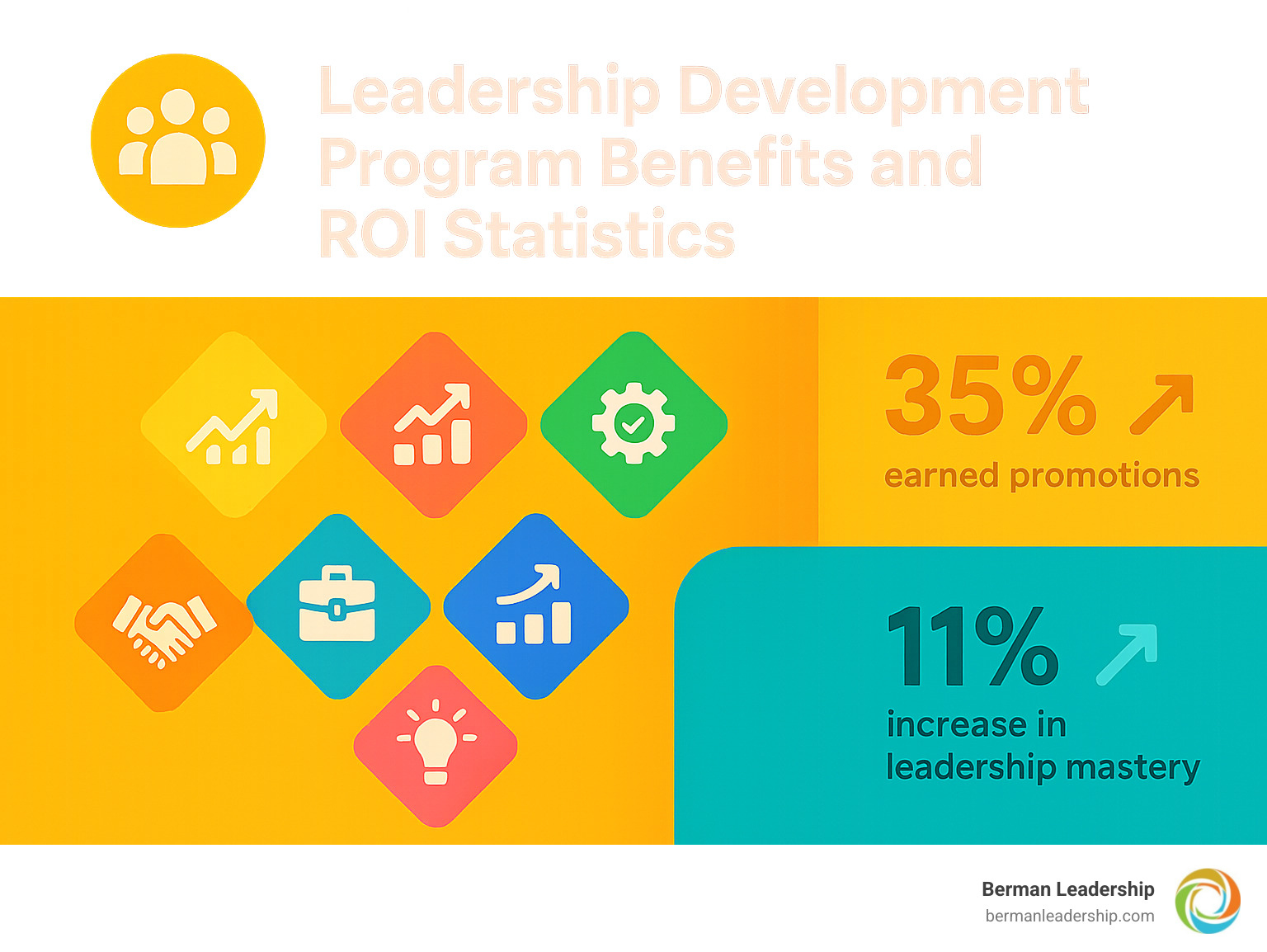As founder of Berman Leadership Development, I’ve seen a common pattern play out over 30 years of coaching executives. Consider a growing theater chain that stalled despite strong market conditions. Their challenge wasn’t strategy or capital—it was leadership depth. Without developed leaders ready to manage expansion, growth opportunities slipped away. Only after implementing a comprehensive leadership development program did they open up innovation projects that increased both revenue and customer satisfaction.
This story highlights a critical truth: leadership development programs are not a luxury but a strategic necessity. They are structured initiatives designed to build leadership capabilities by integrating psychological science with business realities. Effective programs move beyond simple training, incorporating assessment and feedback, experiential learning, executive coaching, and mentorship to build a robust pipeline of future leaders.
Yet many organizations face a disconnect. A Harvard Business Publishing survey found that while 85% of respondents see a need to improve their skills, a third feel their companies don’t provide enough recognition for learning. This gap creates real business risks. The numbers, however, tell a compelling story of what’s possible. At Adobe, 35% of participants in a leadership program earned promotions to Director-level or above, while Freeletics saw an 11% increase in leadership mastery in just three months. These are the tangible results of investing in people.

The Strategic Imperative: Why Ad-Hoc Leadership Fails
I recently worked with a technology company that had everything going for it—brilliant engineers and cutting-edge products. Yet they were stuck. Talented employees were leaving, and growth had plateaued. The issue wasn’t strategy; it was a leadership vacuum. They had promoted their best technical performers into management roles without any development support, creating a cascade of problems.
This scenario is common. Many organizations rely on an ad-hoc approach, promoting high performers and hoping they’ll figure it out. But hope isn’t a strategy. The costs are staggering, not just in lost talent but in institutional knowledge and team disruption. Leadership development is the deliberate process of enhancing an individual’s capacity to lead others and drive organizational goals. When done right, it aligns with business priorities and creates measurable impact.
The ripple effects touch every corner of the business. Strong leaders foster a positive work environment, which is key to opening up potential. This drives employee retention, as people who see a clear path for growth become more loyal. It also fuels innovation by creating psychological safety for teams to take calculated risks. This leads to improved profitability and a sustainable competitive advantage. At Berman Leadership, we help organizations Develop Great Leaders who can build this critical foundation.
What are Leadership Development Programs?
Leadership development programs are strategic, structured initiatives that systematically cultivate leadership capabilities. They are not just collections of workshops but comprehensive systems designed to transform how people think, act, and lead. The most effective programs focus on three critical areas: skill building in tangible abilities like communication and conflict resolution; mindset shifts that foster adaptability and a broader perspective; and business alignment that ensures all development supports the organization’s strategic goals.
A significant component involves identifying and nurturing high-potentials—those individuals with the drive to ascend to greater leadership roles. Our High Potential Development programs are designed to create robust pipelines of future leaders, ensuring the organization is prepared for what’s next.
When organizations commit to this structured approach, the benefits are clear. I’ve witnessed increased employee engagement, higher retention rates, and improved team performance across industries. Stronger succession pipelines develop organically, and a newfound agility and innovation emerge as leaders become more comfortable with ambiguity. These advantages translate directly to better financial results. The question isn’t whether you can afford to invest in leadership development—it’s whether you can afford not to.
Designing for Impact: Core Components of Effective Leadership Development Programs
Creating truly impactful leadership development programs requires more than a training budget; it demands an understanding of the interplay between human psychology and business realities. Over my 30 years in executive coaching, I’ve learned that programs creating lasting change are those that dig into the psychological foundations of leadership while staying focused on business outcomes.
At Berman Leadership, we integrate psychological science, behavioral science, and deep business expertise to move beyond surface-level training. This is especially critical in complex sectors like pharma, finance, or legal services, where leadership agility can be mission-critical. Our guiding principle is to create custom solutions for mission-critical challenges, because a cookie-cutter approach simply doesn’t work. As Harvard Business Publishing notes, designing effective learning programs requires intentional design that fosters genuine growth.
Key Methodologies for Lasting Change
Effective programs orchestrate a symphony of learning experiences. We are guided by the 70-20-10 model, which recognizes that most learning happens through on-the-job experiences (70%) and interactions with others (20%), with only 10% from formal training. This framework ensures we build a rich learning ecosystem.
Experiential learning forms the backbone, where leaders practice skills in real-world scenarios. This is complemented by Action learning, where teams solve actual business problems, fostering critical thinking and collaboration. For personalized growth, Executive Coaching provides one-on-one guidance to overcome specific challenges. We also build powerful mentorship programs and facilitate peer learning to harness collective wisdom. Finally, 360-degree feedback provides a comprehensive view of a leader’s impact, while our targeted Leadership Workshops build specific skills efficiently.
The Critical Role of Executive Involvement and Mentorship
I’ve seen beautifully designed programs fail for one reason: a lack of visible, active executive involvement. The most successful programs follow a leader-as-teacher model, where senior leaders actively participate, share experiences, and facilitate sessions. This lends immediate credibility and relevance.
Sponsorship from a senior leader provides not just advice but advocacy and access, sending a powerful message of belief in an individual’s potential. This helps create a true mentoring culture where guidance and feedback are woven into the organization’s fabric. When leaders at the top model this behavior, it creates accountability and reinforces that development is a continuous journey. This multi-layered support system, involving coaches like those on our team who bring decades of experience, helps leaders understand the crucial distinction between their Intent vs. Impact. This is how new behaviors take root and transform not just individuals, but the entire culture.
Tailoring the Journey: Leadership Development Across the Organization
“We keep promoting our best people,” a frustrated CEO once told me, “but they’re struggling in their new roles.” His company treated leadership development as a one-size-fits-all solution, giving a brilliant engineer the same training as a seasoned director. This is a common mistake. Effective leadership development programs must be custom to the specific challenges and responsibilities at different organizational levels.
Leadership evolves as people move up the ranks. The skills for success as a team leader differ from those needed at the executive level, where strategic thinking becomes paramount. That’s why we help organizations design scalable processes for Leading at Multiple Levels. Think of it like building a house: you need a strong foundation before adding walls and a roof. Competency models and clear career pathing provide the roadmap for what skills to develop at each stage.

For Frontline and New Managers
When an individual contributor becomes a people manager, they enter entirely new territory. Development for this group should focus on foundational skills. This includes learning to delegate effectively, mastering clear communication, and gaining tools for conflict resolution. Perhaps most importantly, they must learn team building—how to motivate diverse personalities and foster psychological safety. Our Leadership Acceleration & Onboarding solutions are designed to build confidence in these core areas, helping new managers learn to “Model, Coach, Care.”
For Mid-Level and Senior Leaders
Leaders in the middle must translate executive vision into action while representing their teams upward. This requires a more sophisticated skill set. Strategic and systemic thinking become crucial, as they must see the bigger picture and understand how different parts of the organization interconnect. They need to learn to influence across functions without direct authority and master change management. Most importantly, their focus must shift from being a top performer to developing others. My book, Influence and Impact, explores these nuances, helping leaders understand that their success now depends on multiplying their impact through others as they Lead at the Next Level.
For the C-Suite and Executives
At the executive level, development becomes highly strategic. The focus shifts to enterprise-wide responsibilities. Vision setting is paramount—articulating a compelling future that rallies the organization. Leaders must master leading through systems, optimizing complex organizational structures rather than managing individual parts, which often involves navigating an Executive’s Ethical Balancing Act. They are the primary shapers of organizational culture and must manage complex stakeholder relationships with investors, regulators, and the community. For these leaders, personalized development is indispensable, which is why What is Executive Coaching? becomes such a critical tool for exploring complex challenges and refining decision-making in a confidential, custom setting.
Measuring What Matters: Proving the ROI and Fostering a Learning Culture
I once worked with a pharmaceutical company that had invested heavily in leadership development. When the new CFO asked about the return on investment, the HR director could only point to positive feedback surveys. The program was nearly canceled until we implemented a measurement framework that showed it had contributed to a 23% reduction in project delays and a 15% increase in cross-functional collaboration.
This reinforced a fundamental truth: if you can’t measure it, you can’t improve it. Proving the ROI of leadership development programs requires a commitment to data-driven decisions. It’s about establishing clear goals upfront and creating a continuous feedback loop that not only demonstrates value but also identifies opportunities for improvement. This approach turns development from a perceived cost center into a proven strategic investment.

Measuring Program Effectiveness
Effective measurement requires a balanced approach, combining quantitative metrics with qualitative insights. Instead of a simple checklist, think of it as a balanced scorecard for leadership growth. Employee engagement scores are a reliable barometer; improvements in trust and clarity of direction often reflect stronger leadership. Promotion rates and the retention of high-potentials are concrete measures of succession planning success. For example, Adobe saw 35% of program participants promoted to director-level roles.
From a Program to a Culture of Continuous Learning
While programs create momentum, real change occurs when organizations cultivate a culture of continuous learning. This requires fostering a growth mindset, where challenges are seen as opportunities and mistakes are learning experiences. The foundation for this is psychological safety, allowing leaders to be vulnerable and experiment without fear of judgment.
This culture is nurtured through recognition for learning and by encouraging social learning through peer-to-peer interaction and mentorship. The most successful organizations treat leadership as a collective effort, where senior leaders act as teachers and mentors. This commitment to upskilling for shared prosperity creates a virtuous cycle, ensuring your organization has the resilient and visionary leaders it needs for the future. We share further ideas on this in our Thought Leadership Resources.
Frequently Asked Questions about Leadership Development
Over my three decades of work, I’ve found that executives and HR leaders often grapple with the same fundamental questions when considering leadership development programs. Their concerns typically revolve around effectiveness, commitment, and implementation. Here are my reflections on the most common themes.
One of the first questions is always, what makes a program successful? The answer isn’t a single ingredient but a combination of factors. Success begins with strategic alignment, ensuring the skills being developed directly address the organization’s most pressing business challenges. It requires customization, as a new frontline supervisor needs different support than a C-suite executive. The methodology must also be a blended learning approach that includes experiential projects, coaching, and mentorship. Finally, success is impossible without active executive sponsorship and a robust system for measuring impact on retention, promotions, and business outcomes.
Another common concern is program duration. Many hope for a quick fix, but sustainable change takes time. While an intensive workshop can build a specific skill in a few days, comprehensive development unfolds over months or even years. True mastery requires a long-term commitment that allows leaders to practice new skills, receive feedback, and internalize new behaviors in real-world contexts. Leadership development is a continuous journey, not a one-time event.
Finally, leaders ask how to identify the right candidates. This is perhaps the most critical factor. The process should be systematic, looking beyond past performance, which doesn’t always predict leadership potential. A multi-faceted approach using manager nominations, 360-degree feedback, and assessments of learning agility provides a more complete picture. This reveals not only an individual’s current capabilities but also their capacity for growth, resilience, and alignment with company values—the true markers of a future leader.
Conclusion: Your Next Generation of Leaders Awaits
I recently spoke with a CEO who said, “Bill, I used to think leadership was about having the right answers. Now I realize it’s about building people who can find better answers than I ever could.” This captures the essence of what leadership development programs can achieve.
The cost of a leadership vacuum is steep. It’s the brilliant manager who leaves for a better opportunity, the missed innovations, and the slow erosion of your competitive edge. But this doesn’t have to be your story. A strategic investment in leadership development transforms organizations by creating empowered teams, building resilience, and fostering a culture where leadership flows through every level.
The fusion of psychological science and business acumen is practical magic. When you understand why people behave as they do, you can design solutions that deliver measurable impact. At Berman Leadership, we don’t use cookie-cutter approaches; we build custom solutions for mission-critical challenges in demanding industries like pharma and finance.
Your next generation of leaders is already in your organization. The question isn’t whether they have potential, but whether you will give them the tools to realize it. Are you ready to transform that potential into performance? Transform your organization with our Leadership Development Programs and find what’s possible when you truly invest in your people.


